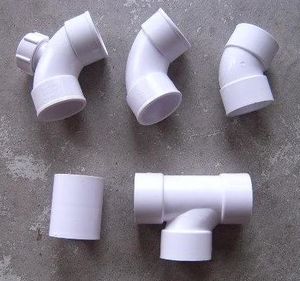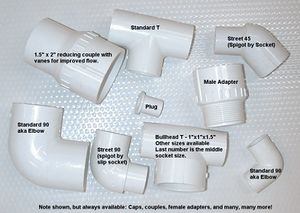Difference between revisions of "Identifying Pressure Rated PVC"
m |
Pilgrimman (talk | contribs) (Added a small thing, will add more later.) |
||
| Line 69: | Line 69: | ||
'''Fittings:''' | '''Fittings:''' | ||
| − | To find out if a fitting is pressure rated, it should have 'NSF-PW' written in raised text, it may also have Sch 40 (or 80,120 etc) on it. Most American fittings don't have a pressure rating on them, but if they have NSF-PW, you're okay, it will be pressure rated. | + | To find out if a fitting is pressure rated, it should have 'NSF-PW' written in raised text, it may also have Sch 40 (or 80,120 etc) on it. Most American fittings don't have a pressure rating on them, but if they have NSF-PW ("PW" stands for Potable Water, which, by nature is under pressure), you're okay, it will be pressure rated. |
'''Pipe:''' | '''Pipe:''' | ||
Revision as of 17:31, 16 February 2008
Pressure Rated PVC is a fairly common type of spudgun material that most spudguns are made from. It can be found at your local Lowes, Home Depot or Ace Hardware in America. If you are outside the US, your best bet for cheap PVC is a Plumbing Merchant, but it can also be found in Aus/NZ at a Bunnings or Mitre10.
Identifying the correct type of PVC to use in a Pneumatic or Hybrid cannon is vital because of the high pressures involved. Combustion cannons don't need to be made from pressure rated pipe, but if you don't mind the weight and cost, go right ahead.
Contents
PVC and Combustion Cannons
Generally most spudders who build combustion cannons will not use pressure rated PVC due to the combustions low pressure spike and the cost and weight of Pressure Rated PVC. About 30-45PSI is generated in hairspray cannons and about 60-75PSI in propane or MAPP powered cannons, which DWV (Non-Pressure Rated) PVC or ABS should be able to take.
There have been few reports of people having combustions made from DWV PVC blowing up on them, but this is probably because of pipe fatigue, thin-wall PVC used or cracks formed from threaded fittings in the chamber.
If you are thinking of making a basic or advanced combustion, DWV ABS is probably the best choice aside from the rarely found, Pressure Rated ABS.
PVC and Pneumatics
Pressure rated components are essential in making a safe pneumatic cannon. Because of the higher pressures reached by Pneumatics compared to Combustions, pressure rated fittings are vital.
Pressure Rated PVC is the most common pneumatic cannon material because of the reasonably low cost, availability and low weight compared to metal fittings. It also suits a pneumatic very well, having a wide range of different types of fittings and usually a high pressure rating.
People have taken DWV up to around 80-120PSI in a pneumatic, but this is definitely not recommended. DWV has no rating, meaning it could blow as low as 20PSI. Just spend the extra few dollars and get the pressure rated stuff.
PVC and Hybrids
Pressure rated PVC (Sch 80) was generally a common material in making hybrids until a few people deemed it too dangerous after several cannon failures around 4-6x mixes.
If you plan on making a hybrid from PVC, NSF-PW Sch 80 PVC is the minimum requirement but it would be best to stay under 4x mixes.
Now most hybrids are constructed from galvanised pipe, which is more expensive in larger sizes and weighs more, but the pressure rating is far higher.
Identifying Pressure Rated PVC By Look
If you are having problems separating Pressure Rated PVC components from DWV PVC, these few differences should make it crystal clear next time you go to a hardware store.
DWV Fittings:
DWV PVC fittings have a few obvious traits that you can use to identify them.
- Shallow sockets, DWV fittings have shorter socket depths in their fittings.
- Ring around fitting, DWV fittings usually have a 'ring' around the outside of the sockets, Pressure Rated fittings, don't.
- Thickness, DWV fittings and pipe are very thin compared to their Pressure Rated counterparts.
- Odd shape, some DWV fittings look very odd and drastically different to Pressure Rated fittings.
Pressure Rated Fittings:
Pressure Rated PVC fittings generally have the opposite traits as DWV fittings.
- Deeper socket lengths
- 'Full' fitting, no rings around the fittings.
- Thickness, thicker then DWV fittings.
- Symmetrical look to the fitting, no odd shapes.
Spud Myth: Even though Bell Reducers look Pressure rated, in most cases they are not. It is best to stick to Reducing Bushings because they usually are always pressure rated, make sure to check first though.
Identifying Pressure Rated PVC By Text
Spud Myth: Sch 40 written on the fitting/pipe does not mean the fitting/pipe is pressure rated, the 'Sch' system is a thickness rating, not a pressure rating. You need to look for NSF-PW.
Tip: On a Pressure Rated fitting, the writing is usually raised and can be read once painted over, with pipe, if you have enough layers of paint you probably can't read it, so make sure to write down what the pipe has written on it before you paint over it.
Note: This is identifying American fittings and pipe. To identify Australia/New Zealand fittings, see below.
Fittings:
To find out if a fitting is pressure rated, it should have 'NSF-PW' written in raised text, it may also have Sch 40 (or 80,120 etc) on it. Most American fittings don't have a pressure rating on them, but if they have NSF-PW ("PW" stands for Potable Water, which, by nature is under pressure), you're okay, it will be pressure rated.
Pipe:
For pressure rated pipe, it should have written on the side: 'NSF-PW Sch 40 (or 80,120, etc) XXXPSI @73F'
XXXPSI, is the pressure rating, it changes depending on the 'schedule' rating and the diameter of the pipe. The pipe may also have a different temperature rating, but the most common say '@73F'.
The pipe may also have 'DWV" written on it, as long as the pipe has a pressure rating, e.g '300PSI @73F' you're okay.
If it doesn't have 'NSF-PW' or pressure rating, chances are it's DWV.
You can also identify Pressure Rated or DWV fittings and pipe by their 'AS' number written on them, but it's not essential to learn. More details about 'AS' numbers coming soon.
Identifying Australian/NZ Pressure Rated PVC fittings:
Since Aus/NZ use a different measuring system, PVC fittings and pipe have a different way of identifying if they are Pressure Rated or not.
Fittings:
To find out if a PVC fitting is Pressure Rated or not, it should have written on it in either raised or plain text, either:
- Class X (The class ranges from A-F, with F being the most pressure rated, usually Class 'C' is a minimum in a pneumatic.)
- PN XX (The PN (Pressure Number) system has ratings ranging from 0-22+. PN 10, 12 or 18 are the most common and PN 10 should be the lowest rated fitting you should use in a pneumatic.)
It's that simple. To find the pressure rating in PSI, multiply the PN number by 14.5. E.g PN18 x 14.5PSI = 261PSI. The PN number is in BAR, to find it in Kpa, multiply the PN number by 100. E.g PN18 x 100 = 1800Kpa.
Pipe:
To find the pressure rating of PVC pipe, use the same system as you did with the fittings. Find the PN or Class number. Try not to get confused with the 'DN' number, which is the nominal diameter in millimetres. E.g DN50 = Diameter 50mm.
As with the American system, there is another way to determine the pressure rating, and that is by AS/NZS number. More information to come soon.

